| Web
and Book design,
Copyright, Kellscraft Studio 1999-2016 (Return to Web Text-ures) |
 (HOME)
|
|
"Others, again, amongst
whom I number myself, love not
only the lore of flowers, and the sight of them and the fragrance of
them, and
the growing of them, and the picking of them and the arranging of them,
but
also inherit from Father Adam a natural relish for tilling the ground
from
whence they were taken and to which they shall return." "Letters from a Little Garden," Juliana
Horatia Ewing. XVII VARIOUS GARDENS This book began
pianissimo with a
rather hesitating account of my own attempts at gardening; it has
continued
crescendo as my experience seemed to broaden and pleasure certainly to
increase
in planting, working, and writing. And it ends, thanks to the goodness
of
stranger and friend alike, fortissimo and allegro too, with garden
picture and
garden sketch in writing, the latter intimate and fresh to a degree,
since in
most instances it is supplied by the garden's owner. It will be readily
seen
that these, like Sir Thomas More's Utopians, "sett great stoore be
theyr
gardeins." From East to West these
gardens lie
in a sort of dipping line across the continent, with the exception of
the
Philadelphia example. But before setting forth on this horticultural
journey,
there are here to be noticed pictures of two gardens at a London flower
show one,
though in an unfinished state when photographed, giving excellent
suggestion in
design; the other beautiful, rarely so, for its flower grouping. These
were
examples of fine gardening on exhibition at the International Show of
1912 in
London by the English firm of Wallace & Company, of Colchester at
that
show which will live in the history of horticulture as the largest and
best
ever held in Great Britain. The little sunken garden carries with it a
quiet
charm of line and proportion. Perhaps the dry wall (farther left of
picture)
might have been more beautifully laid, but from the photograph one
catches the
precious quality of serenity in a garden. The use of flowers is
apparently
somewhat restrained. Eremuri, it will be noticed, are used at regular
intervals, and beside these there are in this so-called English border
iris,
anchusa Dropmore, habranthus, Nepeta Mussini, cerastium, erigeron (a
low,
daisylike flower not often seen in our own gardens), and dianthus. 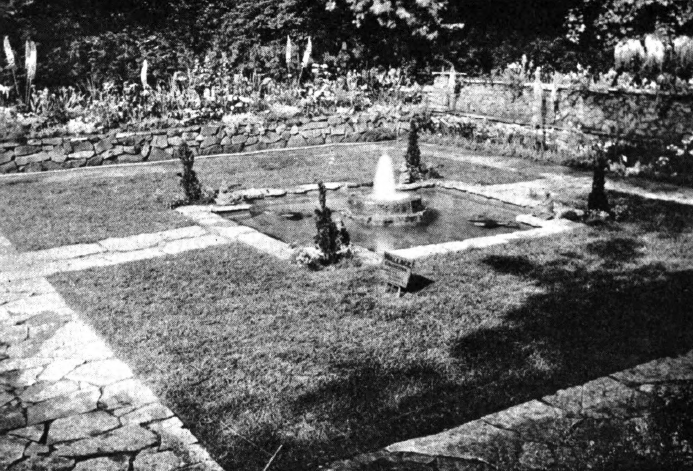 GARDEN AT LONDON FLOWER SHOW OF 1912 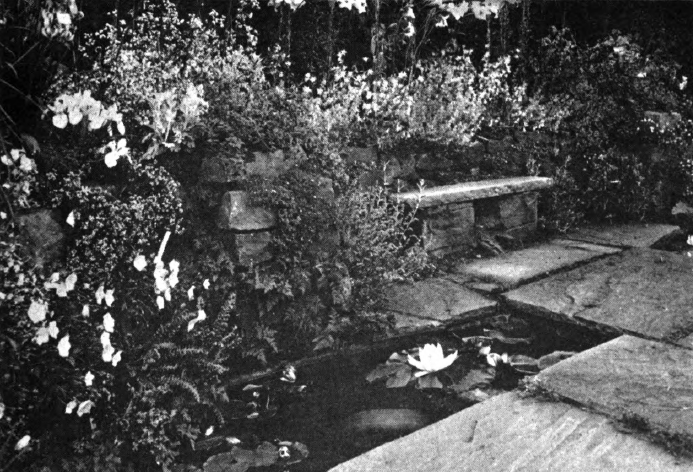 DETAIL OF ANOTHER GARDEN AT LONDON FLOWER SHOW, 1912 In the illustration
showing the old
stone seat a vision of beauty and a most lovely example for the
American
gardener the things which surround the seat are for the most part
plants with
scented foliage. Campanula Carpatica, however, may be noticed here;
also
irises, hypericum, and again erigeron, a variety by the name of
Quakeress. The
masses of delicate aspiring flowers back of the seat and below the
Madonna
lilies are, I fancy, either anchusas or heucheras in bloom. And, may I
ask, was
ever that flower beloved of poets and writers of songs, the water-lily,
as perfectly
set as in this place? Notice, too, the small ferns so cunningly placed
as to
overhang the pools. In this picture nothing is overdone the walls are
not
smothered under flowers nor is the dark water hidden by mats of
uninteresting
lily-pads, as is too often the case when one has a fancy for aquatics. Taking now our gardens in
non-geographical order, but in their general groups as Eastern,
Western, and
Middle Western, we will look first at the two in the Middle West. This,
happily, we may do through the medium of the pens of the gardens'
owners. The
first description is of an Ohio garden at Gates Mills, not far from
Cleveland;
the second a lawyer's garden in the lively and agreeable city of Grand
Rapids,
Michigan. The descriptions follow as given me, even to the humorous
thrust in
the line which concludes the second. "My garden is like my
house;
perhaps that is what all gardens should be. But it has pleased me to
play that
the old lady, with New England traditions, who built the little cottage
seventy
years ago, made a garden to go with it, which has gone on seeding
itself and
tangling all sorts of things up together. "There is an uneven stone
walk
leading from the gate to the front door, and before the deed of the
place was
in my possession I had planted on either side of it a border which
blooms from February,
when the snowdrops appear, until December, when the snow covers the
chrysanthemums still gayly flowering. 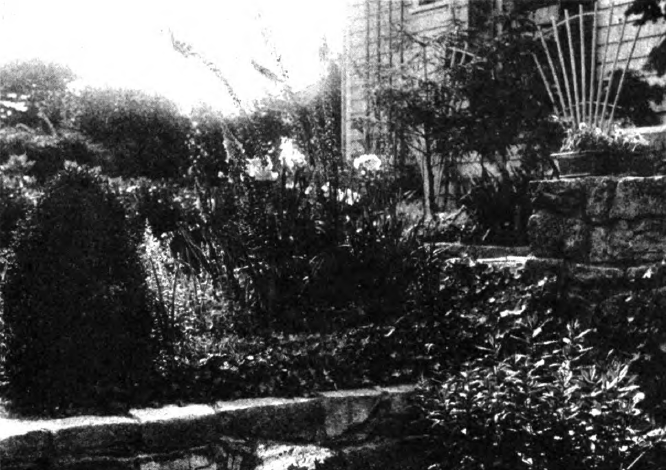 TERRACE PLANTING, GARDEN ON NANTUCKET 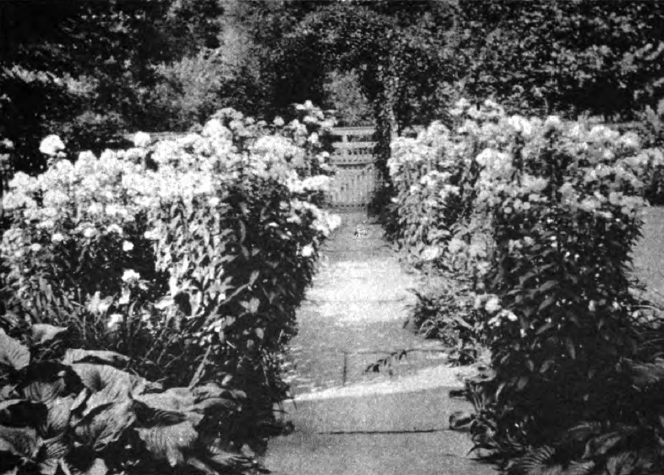 PHLOX TIME, GARDEN AT GATES MILLS, OHIO "Old-fashioned flowers
have
always had the preference, though I have had to slip in the lovely blue
salvia,
Japanese anemone, summer hyacinths, and others which, alas, the first
owner of
my bit of ground never knew. There must be the historic 'fifty-seven
varieties'
in these borders, which are my chiefest joy. Next is the bed around the
sun-dial with its foundation of an old millstone for this is a Gates
Mills
garden. Here only things with spiky leaves are allowed to grow. The
crocus
begins the season; daffodils, scillas, all sorts of iris, yellow
lilies,
yuccas, gladioli, montbretias follow in procession until summer
hyacinths and
red-hot poker end the summer in a charming combination, and not one of
them but
has the long, slender leaves. My latest joy is my white border
connecting two
sets of beds where many old and some new fashioned flowers are massed
according
to a plan which does change somewhat every year, as my visions of color
combinations vary. What a lot of white flowers one can find to crowd in
front
of the background of tall white phlox! For close planting carries out
my
pretending that it is really Mrs. Gates's old garden instead of an
imitation of
a dozen years' growth. "Here are all the
white-flowering bulbs, and rock-cress, sweet-william, columbine,
lilies,
peonies, Japanese anemones, achilleas, the lovely Campanula
pyramidalis, summer
hyacinths, feverfews; and after the bulbs have faded away every spot is
filled
with white annuals. "This border has just had
its
first birthday, but in my imagination that first necessity of a
garden a
charming and still more charming future stretches out before this band
of
lovely whiteness. "These and the long arbor
with
its flowering vines are the parts of my garden nearest my heart, the
rest is
just garden." The description of the
Grand Rapids
garden is next in order. "The conditions to which
my
flower garden is subject have made it what it is. These conditions are:
"1. It is close to my
house and
not so large but that every part of it is always in full view
therefrom. "2. I restrict myself to
a
garden which I can care for without a regular gardener and with only
occasional
hired help. "Because of the first of
these
conditions, the garden is always on parade. It must, therefore, be
always
sightly throughout its entire extent. So it must be treated as a whole;
for
pleasing beds, or groups of flowers, without regard to the condition at
all
times of the rest of the garden, will not produce a result always
beautiful in
its entirety. That effect will be the result not of the flowers alone,
but of
flowers, plants, and foliage, so massed and grouped as always,
throughout the
season's changes, to convey to the eye a pleasing impression of the
garden as a
whole. This involves consideration of the flowers, foliage, and habit
of growth
of each of the plants used, and of the time of its growth, its bloom,
its
decline and decay. It requires the proper grouping of all that the
garden
contains, so as to cover the ground, to hide unsightly plants in their
decline,
to present always a pleasing sky-line, and to secure harmony of color
in
foliage as well as in flowers. This is to treat the garden as a
picture; and
these things are the main factors in its composition. To make the
picture
effective in its place there must be a relatively large quantity of
flowers,
the high lights of the picture, and also an unbroken succession of
bloom. The
flowers chosen for this purpose should be reliable and prolific
bloomers, and I
think that only such kinds should be used as yield the most beautiful
and
effective flowers that can be had at the particular blooming season of
each.
Why seek to get results by using flowers insignificant in themselves
when these
results may be got with flowers that are more beautiful as single
specimens? "To obtain my unbroken
succession of bloom and the other results I have outlined, I have used
the
following: crocuses, daffodils, Darwin tulips, German irises and pink
Oriental
poppies, peonies, Thunberg's lilies, larkspurs and Madonna lilies,
Japanese irises,
pink annual poppies, phloxes, late aconites, and Japanese anemones.
These may
be called my main-line forces, although nothing in the garden is
planted in
rows or in lines or according to any set figure or design.
May-flowering
scillas, heucheras, Rocky Mountain columbines, leeding-hearts,
broditeas,
ixias, lupines, gladioli, etc., come in as aids or reinforcements to
add to the
beauty and gay effect. Peonies and late aconites, on account of their
lasting
foliage, are used not only for their flowers but with reference to the
sky-line
and to desired screen effects. In this I am greatly aided also by the
thalictrums and native ferns. Out of beds of the last-named come up
many
daffodils, tulips, and lilies. The peonies allow the larkspurs as well
as the
Dutch bulbs to retire and hide their unsightliness after they have
bloomed. By
the aid of the lasting foliage and difference in height of these
plants, I am
able also to obtain a varied and pleasing sky-line and to keep the
ground from
showing bare or unsightly spots. I have had more difficulty in treating
the
garden picture as regards these things than in matters relating to
flowers and
color in the garden. "My way of treating the
garden
for successional bloom and for continuous sightliness involves planting
many
crops in the same space. No plant has any exclusive preserve in my
garden. All
are set in irregular groups or drifts, one kind crowded on top of
another. In
the same space the various kinds come up, put forth leaves and
branches, bloom,
and die down, or serve as ground screen all in their allotted times,
and
according to their respective habits. This promiscuous commingling and
crowding
of races involves a 'struggle for existence'; but since things follow
in
succession it is chiefly a question of sufficient fertilizing, rather
than of
room or of light and air, so far as the flowers and garden plants are
concerned. It is the weeds that this struggle bears most heavily upon;
for such
thick and constant cover as results from my scheme of planting holds
them down.
It also holds moisture and minimizes the necessity of cultivation, and
thereby
I satisfy the second of the conditions which I stated at the beginning.
"A little thought will
show
that a garden maintained on the plan outlined is no place for annuals
or for
most of the biennials. It is too crowded for their development, and,
moreover,
too much labor is involved in raising and renewing them. For the same
reasons
perennials that are difficult, or that run out in a year or two, are
excluded,
although I am still over-indulgent to the peach-leaved campanulas, the
late-flowering aconites (chiefly on account of their height and the
lateness
and excellence of their foliage), and to the capricious Rocky Mountain
columbine. "It is obvious, too, that
color
and color schemes are not the first thought, or the last word, in my
garden.
Flowers are not invited to grow there because they are pink or blue or
mauve or
this or that art shade. Color is not the test determining whether a
given
species or variety can come in, but, so far as it is a test at all,
whether it
must stay out. Even if the color be satisfactory and harmonious, yet if
the
plant is bad in its habits, if it sprawls and is unsightly, if it is
hoggish
and overruns its neighbors, it cannot get in. Color in this garden is a
material factor in making the picture, only in the same way as beauty
of
foliage or of sky-line. Its importance may be greater, but that is a
matter of
degree only. Beauty of color and color harmony are essential, because
if the
colors are bad, or if they jar, the effect of the picture will be
spoiled.
Color combinations and color schemes have no other recognition,
however.
Now come
four Eastern gardens. Two
are upon the Atlantic coast, one in the hills of Berkshire, and the
third in a
suburb of the most finished of all American suburbs, those of
Philadelphia. On Nantucket Island has
been created
a garden spot which, from its very pictures, so delights me that to
sometime
see it, its lights and shadows, its lovely watery distances, is a thing
to
expect with special pleasure. This garden is the more successful when
one hears
that its space is restricted, that its proportions are perhaps one
hundred and
fifty feet deep by fifty wide, and that the ground was originally the
site of
an ancient dwelling. The old levels of cellar and main floor were
scrupulously
and closely retained giving the necessary drop for two short flights of
low
steps. Along the street line there is a fence. Steppingstones go
through the
entire garden, which overlooks at the opposite end the harbor of
Nantucket. As
foreground for this lovely picture of water, tree and flower have been
used
with a most excellent eye for effect. The house is connected with the
garden by
a terrace of brick and against the wall of this terrace is a fine
border of
annual flowers. The first or lower garden, next the house, is oblong;
the
second square; the third informal in treatment, with the sea-lavender
leading
up to a charming little pool with goldfish papyrus growing there. In the cut, page 144,
showing a part
of the terrace wall, one notices the old-time, fan-shaped supports for
roses
always a feature of the early New England garden. Here are seen tall
foxgloves
rising from groups of the wonderful Iris Kaempferi, the little pointed
box-tree
at the left a good foil for the gay colors of the flowers. Everywhere
balance,
symmetry that regularity which is perhaps more precious for the small
piece
of ground than for the large, since it produces, in little, effects
both
agreeable and finished. In the foreground of the highest garden shown
in the
illustration a perfect use is made of Statice latifolia, or,
appropriately,
sea-lavender. Below these plants, the beauty of whose purple bloom
against the
distant blues can be but faintly imagined, one may notice little gleams
of
sweet alyssum and, looking straight toward the sea, their flowers
shining
against the green of the next lower level, one sees delphiniums most
happily
introduced into the picture. Flowers found in this garden are, with
others,
Shasta daisies and many purple and yellow Japanese irises; hedges and
box-trees
everywhere to form enclosures, to afford backgrounds, to give that
richness of
dark green always peculiarly effective near the sea. The photograph of
this
garden with its sight of ocean is one of the loveliest gardening
compositions
ever falling beneath my eye; I am delighted that it may grace these
pages
(frontispiece). At Swampscott, Mass., set
upon a
great ram-part of rock overhanging the Atlantic, is a series of small
gardens
on a property of three acres. The forms and flowers of these gardens
send one's
thoughts swiftly to divers beautiful parts of the earth. The house in
this case
has a site of great picturesqueness. It is also true that good minds as
well as
good gardeners have been at work here. Ingenious, indeed brilliant, use
has
been made of boldly varying levels, of the suddenly changing outlines
of the
property as a whole, of the glorious outlook upon the sea. Entrance to the house
from the
highroad is obtained through a bit of wooded land, passing on the left
the
first of a group of gardens on lower and yet lower levels. This is the
sunken
garden of one hundred by fifty feet. Surrounded by a broad grass walk,
bordered
on one side by an arrangement for two periods of bloom of dahlias and
hollyhocks, this is an English garden of perennials. The design shows
four
balanced beds, with central features in the form of three circular
ones. Of
these the middle is kept in turf, the endmost circles delightfully
planted as
color-harmonizing foci for their gay surroundings, in hues of lavender
and
white. One of these circles is filled with white geranium bordered by
lavender-blue
ageratum, the other has for occupants heliotropes encircled by a band
of sweet
alyssum. 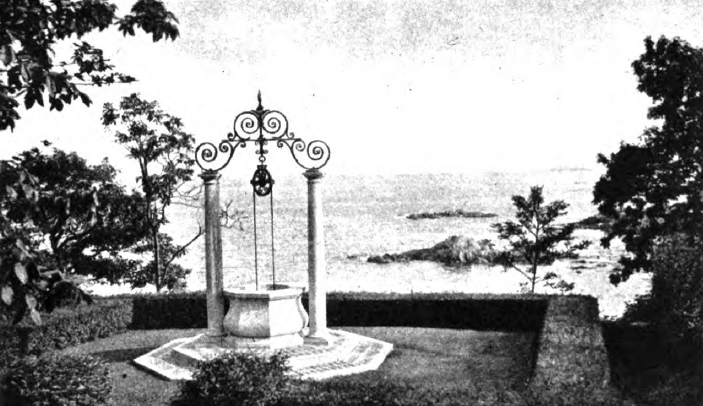 AT SWAMPSCOTT, MASSACHUSETTS 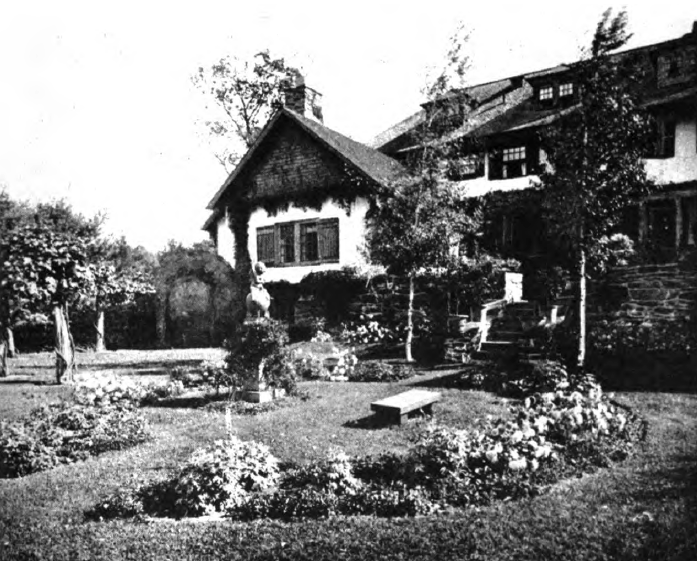 FERNBROOK, LENOX, MASSACHUSETTS Terraces are here with
fine
retaining walls, well-planted terraces; curving stone steps and walks
also
curving follow the line of the precipitous rock which divides the wild
from the
cultivated part of this place; a charming fan-shaped rose-garden
occupies a
secluded spot but with its own view of the ocean. A little platform of
greensward enclosed by a square-clipped hedge of privet forms a base
for the fine
Italian well-head with its "overthrow" of restrained design shown in
the illustration. All this clear green and dazzling architectural
whiteness
shines against the blue expanse of sea and sky. And in another portion
of the
place such blooming of Iris Kaempferi takes place as is seldom seen
away from
the Flowery Kingdom. (By the by, why does not some one have the sense
and grace
to call his or her garden by this ever-charming title?) It is with the mind's eye
only that
I have seen this garden. May it be my happy lot to walk in it at no
distant
time. While the work it requires is done, its mistress assures me, only
by
herself and her Italian gardener, the harvest of flowers here above the
"unharvested sea" is truly remarkable. There is at Lenox, in the
Berkshire
Hills, a place with the musical name of Fernbrook Farm. It is high on
one of
the glorious hillsides between Pittsfield and Lenox and reached by a
romantic
drive through pretty by-roads. The house itself is of white stucco and
dark
wood and here the eye catches first of all, perhaps, the decorative use
of
fruit, especially of rich black grapes, as the vines are caught upward
above
windows of the second story. The clusters hang clear and beautiful from
the
stem all the way up; few leaves are allowed to remain. Japanese plums
and
crabapples grow as espaliers, and the effect of this bold decoration of
fruit
and leaf against the white stucco gives an Italian touch, a lovely
reminiscence
of that land of sun and shadow. At the back of this
house, looking into
the mountainside, there is first a grass terrace in a court made by the
projection of two wings of the house upon it; a fe'w steps down a
second and
much larger terrace. Here is a fine sun-dial, a bronze cupid astride a
globe "Love
Ruling the World," modelled by the artist-owner of Fern-brook. Flowers
are
so disposed about the pedestal as to beautifully adorn it. At the
farther side
of this main terrace, through a small pergola covered with berried
matrimony-vine occurs a descent of a few steps into a long pleached
walk of
apple-trees running through the kitchen garden. In places the steep
balustrades
leading from the first to the second terraces are accented by the use
of dwarf
apple-trees in pots. These were in fruit when I saw them, and the
shining red
globes in the green leaves against that Italianesque wall of white were
again
good to see. Italian gourds hanging through roofs of light pavilions
and
against trellises showed a fine use of what to me was a new
horticultural
subject, physalis, the Chinese lantern plant, with its vermilion fruit
lighting
the borders against the house on the upper terrace, and higher up its
color was
repeated by festoons of scarlet peppers and tomatoes hung with careless
art
against the plastered wall. Actinidia arguta, the fine creeper from
Japan, and
our native bittersweet were in evidence here, very much thinned as to
branches
but full of fruit. The garden proper at Fernbrook Farm has been built
on a bit
of level and projecting ground before and to the left of the entrance
front of
the house. This is an oblong hedged garden planted gayly in long narrow
beds
with delphiniums, roses, and very fine scabiosas. At the garden's end
farthest
from the entrance is a circular pavilion, an informal gazeebo, its roof
a light
framework of rods or canes. Along these run bold vines full of
blue-black
clusters, this fruit of the vine hung against a distance of valley and
mountain
rich in every autumn color and bound together by that heavenly October
haze of
blue. It was in
October, too, that I saw
another garden, Fancy Field, at Chestnut Hill, near Philadelphia. In
the soft
autumnal light the summer freshness of all green was touched here
almost to the
gray-greens of Italy. Would that my memory of this garden equalled my
delight
in it! I might then hope to describe with some degree of accuracy what
I so
enjoyed upon that day. My recollection is of garden after garden, one
out-of-door apartment after another, perfectly connected, with a most
knowing
use of structural green in the way of hedges low and high; of the quiet
effect
of broad spaces of hedge-enclosed turf; of one garden modelled upon the
Lemon
Garden of the Villa Colonna at Rome; of another, illustrated here, a
reproduction of the Dutch Garden at Hampton Court made in the time of
William
and Mary; of a third, a knot or parterre fashioned after an ancient
pattern
still existing somewhere among the English dukeries all these
enchantingly
enclosed and giving a series of delightful surprises; and last, a
remarkable
pergola at the back of all the gardens and bounding their whole length.
This,
very high, was so well proportioned that to look either at or through
it gave
instant pleasure. At the moment, too, all of its great rose-vines
carried but
bare stems. In this garden one had everywhere the sense of proportions
finely
maintained. The use of dwarf fruit-trees and of espaliers; of box, of
privet,
and of poplar in hedging; of slight but effective bits of terra cotta,
marble,
and stone now and again in these gardens, was exceedingly good. Indeed,
a few
pieces of bright Italian faience made one spot in the garden "si gai et
si
coquette" that the brightness of summer itself seemed to be caught and
held there for the further beauty of that autumn day. 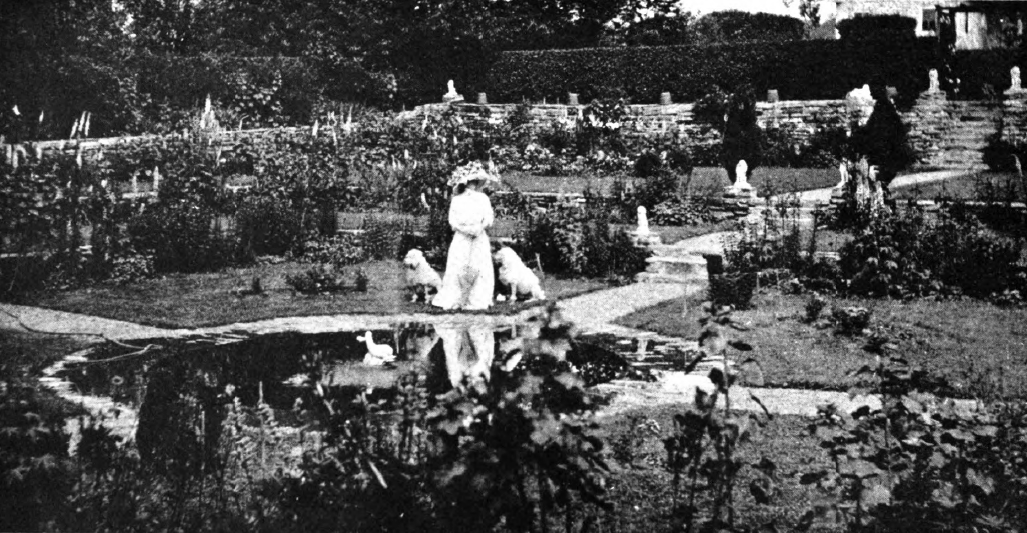 FANCY FIELD, CHESTNUT HILL, PENNSYLVANIA Is there not true and
tranquil
beauty in the picture of one of these gardens? June, with some late
foxgloves
just overlapping the first delphiniums; and the cleverest introduction
of the
two dogs into the picture, quite unconscious that they are the living
repetitions of those lions cut in stone! The end of my chapter comes
quite
naturally with those gardens which lie toward the setting sun. Two gardens near Tacoma
fill me with
envy of that wonderful climate of the Pacific coast. Lavender
flourishes in
Tacoma gardens; the broom is magnificent in May on the prairies which
stretch
from Tacoma toward American Lake some ten or twelve miles from the
city; and
here the heaths are at home as well, both Scotch and Mediterranean. The
winter
is mild, with much rain; the summer cool but rainless, therefore
constant
watering of lawns and flowers in the latter season is the practice. A
glorious
picture of natural planting presents itself upon these prairies where
superb
spruce-trees are so cunningly grouped in colonies as to give an
appearance of
the utmost achievement in studied art. At the far edge of one of these
great
natural parks we drive through a grove of beautiful dark trees and come
suddenly upon a rustic gateway dripping with pale-pink rambler roses. We pass inside the gate
between
short bordering beds of hybrid perpetual roses, turn sharply to the
right, and
behold one of the most lovely flowering vistas it has ever been my good
luck to
see real and living. It seems painted; it is too good to be true, this
artist's
arrangement of colors within a long pergola built of saplings with the
bark
still upon them. "I made it all myself," delightedly exclaims our
hostess as our unconcealed surprise and pleasure in this lovely garden
pour
forth in excited talk. On the right, entering the pergola a pergola
with a
raison d'κtre, for it conducts from gate to house are gray foliage of
pinks,
Canterbury bells back of those; farther down, masses of Shasta daisies,
gigantic here in stature; beyond those, clouds of the gray gypsophila;
and then
a delicious mass of color in tones ranging from pale lavender to
deepest
purple, the flowers most excellently grouped, an effect of carelessness
which
in an informal border is supremest art; among the flowers used, the
hyacinth-flowered
candytuft which Burpee sends out, here appearing in pinkish mauve, deep
purplish pink, and white; purple pansies snuggling among these; rich
purple
annual larkspur sending up a few spires here and there; and climbing
above all
a lavender and mauve sweet pea, faint notes of the color below
reflected in the
air. Pictures are here shown
of the
rustic tea-house, or recessed arbor, at one end of this pergola
immediately
after its erection (this is now wreathed in rambler rose Dorothy
Perkins); of
the pergola itself in its first summer, a tangle of scarlet dahlias;
and in the
following summer, when annuals were the mainstay. During the third
summer these
were the subjects here: decorative dahlia Golden West, white dahlias,
and a
hundred feet of Burpee's Superb Spencer sweet peas, some unusual
Spencer
seedlings among them, especially the heliotrope Tennant Spencer. No
reds, not a
red blossom in the pergola! Outside of it are white dahlias and white
sweet
peas. Turning again to the
prairie for a
mile or so farther, our road leads again to the lake. Here is a
surprise of a
totally different character. Tacoma's "year one," as some one has
said, is the year 1889, yet twenty years later, only twenty years
later, here
stands, surrounded by giant firs, between whose columns the blue
reaches of the
lake and the greener blues of distant shores are seen, an English
house, a
dignified and serene country house of the earlier Tudor period, with
walled
garden and lily-pool. The latter is set at a suitable distance from the
house
for effect from the second-floor windows; and a large cutting-garden,
formal in
design, lies farther back toward the prairie. The wonder of the main
garden
lies in the fact that it has been most skilfully placed on an axis with
that
noblest of American peaks, Mount Tacoma. Clouds hid the mountain vision
on the
day of my visit, but what a sensation to see Mount Tacoma from one's
garden! 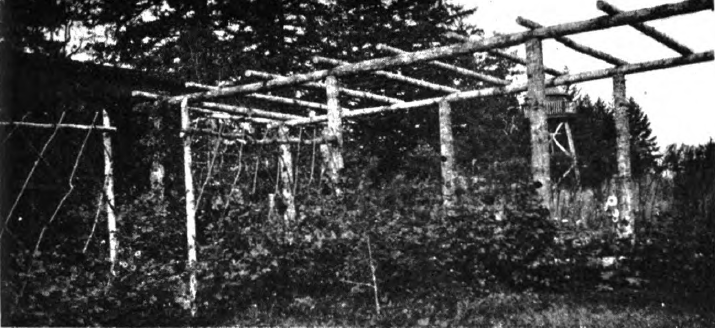 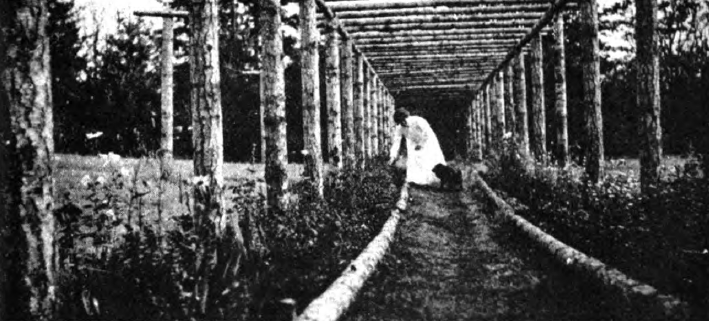 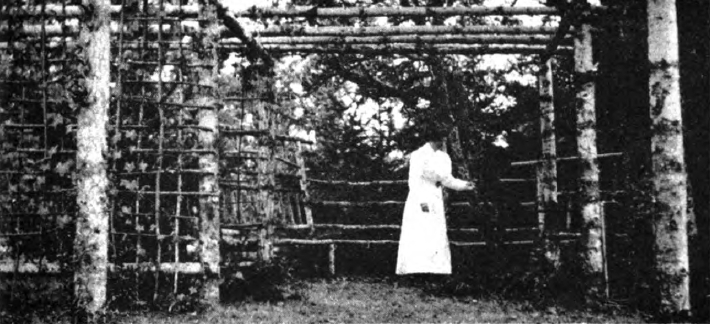 RUSTIC ARBOR AND PERGOLA IN TACOMA GARDEN FIRST YEAR To
come upon this English picture,
this delightful red-brick house, its low outlines possessing much of
the
sweetness of the ancient English manor-house, with its gardens masterly
in
design and rich with flowers to come upon this, in the farthest
Northwest, in
the new country, is to find a thing almost unbelievable. "And I saw in
my
dream" yet the dream is a reality. One recalls the beautiful house of
Kipling's in "They" it is here in America, in that noble State of
Washington, near Tacoma. For the following
description, full
of sympathy and charm, of the gardens of Glendessary, not far from
Santa
Barbara, I am indebted to the owner herself. Parenthetically may it be
said
here that nothing the writer has ever seen in pictures has so
strengthened her
desire to see California as have these entrancing vistas full of color
and of sunlight,
the roses and the fountains, of this so evidently cherished garden. Writing first of the
picture shown
here, the garden's owner says: "This is taken from the edge of a
fountain
basin looking toward the house. The trees are Italian cypress, and oaks
in the
extreme background. 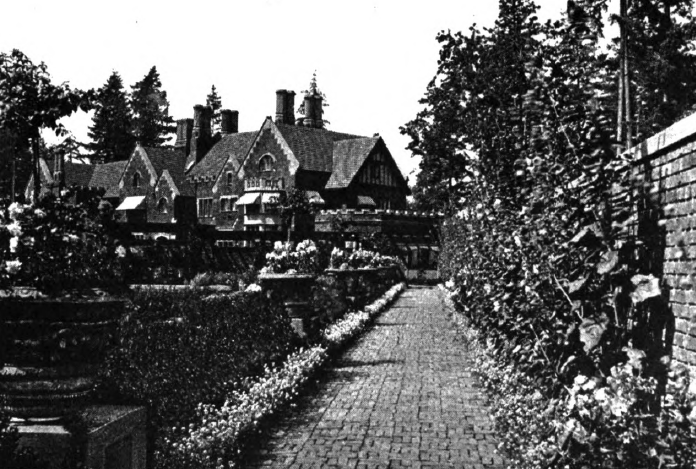 THORNEWOOD, AMERICAN LAKE, TACOMA  GLENDESSARY, SANTA BARBARA, CALIFORNIA "The large bushes in the
foreground are: right, the yellow Southern jasmine, Thuya aurea,
fifteen feet
high; pale-purple veronicas; the rough stone copings laid in sand along
the
paths are covered with Ficus repens. Left, Southern jasmine, Laurel
nobilis,
Swainsonia, and various small things. This left bed is filled with
Camellia
Japonica in different colors, which bloom profusely from November to
May and
are too perfect for words. They are small yet, not more than four feet
high.
There are palms alike in each bed, the Chamerops excelsa, whose very
delicate
fanlike leaves quiver with the faintest breeze. At the second steps
there is a
high green clipped hedge which encloses and also separates the Little
Garden
from the forecourt, in which there are only the lawn and the oaks with
a stone
railing. "It was in 1902 that we
began
taking the scattered rocks and bowlders out of the small piece of
pasture,
through which an old stream-bed still could be followed, and built the
walls
around the `Little Garden,' as it is called, to distinguish it from the
Orchard, the Rock Garden, and the Shrubbery, etc. The ideas expressed
in this
small place were harmonious color, fragrance, plants mentioned in
literature,
and water. There were several large ' Live Oaks,' as the California oak
is
called, in the enclosure, which served as a starting-point for the
walls, the
seats, and the general shape of the garden. A formal plan of walks and
beds was
decided upon in the first place, varied slightly by the position of
existing
objects in the way that a Turkish rug varies from its pattern in
places. I am
told by garden architects that it is not exact enough, but I could not
bear to
lose a single old tree; and the mathematical glories must suffer a
little. "A garden seems to me a
collection of the flowers one loves best or has a very dear association
with in
one's mind from poems or books, and mine began with Laurus nobili8 and
orange-trees, jasmine and ivy, and climbing roses on the walls Madame
Alfred
Carriere, La Marque, and Olga of Wtirtemberg, Celine Forestier and
Beauty of
Glazenwood the white wistaria in the oak-trees in the spring and the
Daphne
odorata and lemon verbena to lean over and breathe in. . . . The pool
in the
centre is full of brilliant lilies, and the lotus-tank below is, in
summer, a
lovely group of perfect beauty around which the darting green
dragon-flies, the
humming-birds, and bees are constantly seen. The colors are very
carefully
considered, and the flowers are separated by green shrubs and plantings
which
break the garden into many nooks and corners. "Everything will grow in
California if the proper care is taken, and the succession of flowers
is a
never-ending source of happiness. The earth is quite covered, as there
are many
low-growing plants, which serve as a setting for their more ambitious
sisters;
and, since we cannot easily have grass, the earth must be covered with
tiny
plants. The use of plants in pots is also very helpful in places where
one
needs a certain form or color; and the big, coarse red Mexican jar made
in Los
Angeles is a great boon. We have many plants indigenous to California
which are
most valuable to the lover of formal gardening; among them the numerous
agaves
and aloes fill many an important spot." It is gardening such as
this which
gives joy to the discriminating; it is beyond all a question of the
mind and
eye. The nobler the intellect, the more poetic the imaginative vision,
the
happier he or she who gardens. And is there any one so happy as the
fortunate
possessor of a bit of ground and the wish to give a loveliness higher
than
earth has yet been known to show? He who has done this should be a
supremely
happy man, and "to the supremely happy man, all times are times of
thanksgiving, deep, tranquil, and abundant, for the delight, the
majesty, and
the beauty of the fulness of the rolling world." |